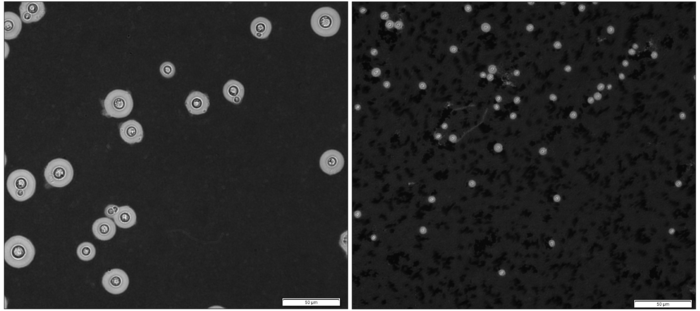(Salt Lake City) – A fungus that is a common cause of fungal meningitis undergoes a remarkable transformation once it enters the body, allowing it to infect the brain, according to new research by scientists at University of Utah Health. Studies in mice show that as the fungal intruder travels through the body, it shrinks and acquires characteristics that help infection to spread, all in a matter of days.

Credit: Steven Denham
(Salt Lake City) – A fungus that is a common cause of fungal meningitis undergoes a remarkable transformation once it enters the body, allowing it to infect the brain, according to new research by scientists at University of Utah Health. Studies in mice show that as the fungal intruder travels through the body, it shrinks and acquires characteristics that help infection to spread, all in a matter of days.
The discovery could lead to new strategies for blocking Cryptococcus neoformans infection and preventing detrimental effects on the host. C. neoformans is the leading cause of a rare but deadly swelling of the brain that occurs in people with weakened immune systems.
“Cryptococcus cells in the lungs are very diverse with different sizes and different appearances. So, when my graduate student showed me pictures of the uniformity of cells from the brain, I was shocked,” says Jessica Brown, Ph.D., associate professor of pathology at U of U Health and the study’s senior author. “It suggested that there was some very strong reason why only this population of cells were making it that far into the body.” Her former graduate student, Steven Denham, PhD, is leading author on the study. Their research recently published online in the peer-reviewed journal Cell Host & Microbe.
The fungus adapts rapidly to withstand microenvironments in the body
Brown’s fascination with the fungus came from the observation that it thrives in so many different habitats. In the wild, the organism lives in rotting wood and bird droppings. If it is inadvertently inhaled, the fungus can survive in the lungs and then travel in the bloodstream to the brain and other organs, each of which has its own challenging micro-environment.
Previously, other scientists found that the fungus copes with living in the lungs by growing to 10 times its normal size, presumably becoming too large for the host immune system to destroy. But in other parts of the body, fungal cells are much smaller. Brown wondered, could the cells’ extra-small size be another type of advantage? Perhaps that characteristic helps them colonize other organs, such as the brain.
To find out, her team infected mice with various sizes of C. neoformans. They found that in comparison to medium and large cells, the smallest cells preferentially infected the brain. These cells were not only diminutive but differed in other ways. Compared to larger fungal cells, they had unique features on their surface that were similarly important for accessing the brain. They also turned on a different set of genes.
This evidence suggested that the small fungal cells, that Brown dubbed “seed” cells, were not just miniature versions of larger cells. They had undergone a wholesale change.
After searching for triggers, Brown’s group found that a specific chemical—phosphate—could induce the shift. Knowing that phosphate is released when tissue is damaged during infection, Brown speculates that the chemical accumulates in the lungs, the first site where fungi settle after entering the body. This allows the fungal cells to reconfigure themselves as seed cells, which enables the infection to spread further.
From bird guano to the brain
Oddly enough, the fungi’s ability to effectively target the brain may have originated from a unique source: bird guano. C. neoformans thrive in pigeon droppings, which have high levels of the seed cell-triggering molecule, phosphate. Brown’s team found that the gooey stuff nudges C. neoformans into that alternate state like nothing else they had tried.
Brown thinks this could demonstrate how the fungus’ pathogenicity arose in the first place. “We think that selective pressures from environmental niches like pigeon guano are somehow able to confer to C. neoformans the ability to infect mammals,” she says.
Regardless of how the fungus’ infectious property arose, Brown’s team is now trying to block that ability with FDA-approved drugs. They are determining whether there may be an existing compound that blocks C. neoformans from becoming seed cells that could provide a ready-to-go remedy for preventing or treating fungal meningitis.
# # #
In addition to Brown, co-authors are Steven T. Denham, Brianna Brammer, Krystal Y. Chung, Morgan A. Wambaugh, Joseph M. Bednarek, Li Guo, and Christian T. Moreau from U of U Health.
The research published as, “A dissemination-prone morphotype enhances extrapulmonary organ entry by the fungus Cryptococcus neoformans” with support from the National Institutes of Health.
About University of Utah Health
University of Utah Health provides leading-edge and compassionate care for a referral area that encompasses Idaho, Wyoming, Montana, and much of Nevada. A hub for health sciences research and education in the region, U of U Health has a $428 million research enterprise and trains the majority of Utah’s physicians and health care providers at its Colleges of Health, Nursing, and Pharmacy and Schools of Dentistry and Medicine. With more than 20,000 employees, the system includes 12 community clinics and five hospitals. U of U Health is recognized nationally as a transformative health care system and provider of world-class care.
Journal
Cell Host & Microbe
DOI
10.1016/j.chom.2022.08.017
Method of Research
Experimental study
Subject of Research
Animals
Article Title
A dissemination-prone morphotype enhances extrapulmonary organ entry by the fungus Cryptococcus neoformans
Article Publication Date
12-Sep-2022
COI Statement
No COI




